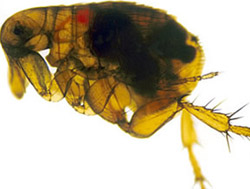Yersinia pestis
Yersinia pestis is a Gram-negative bacterium that belongs to the family Enterobacteriaceae. It is a rod-shaped, nonmotile, and facultative anaerobic organism that is primarily known as the causative agent of plague, a disease that has caused several pandemics throughout human history. The most notable of these pandemics include the Justinian Plague, the Black Death, and the Third Pandemic, which collectively resulted in the deaths of hundreds of millions of people. Yersinia pestis is transmitted to humans through the bites of infected fleas, direct contact with contaminated fluids or tissues, and inhalation of respiratory droplets from a person or animal with pneumonic plague.
Biology and Genetics[edit | edit source]
Yersinia pestis is characterized by its ability to infect and multiply inside the lymph nodes, lungs, and blood of its hosts. The bacterium possesses a number of virulence factors that enable it to evade the immune system, including a type III secretion system (T3SS) that injects effector proteins into host cells. Its genome consists of a circular chromosome and several plasmids that carry genes critical for its pathogenicity and survival in both fleas and mammals.
Transmission and Disease[edit | edit source]
The primary vector for Yersinia pestis is the rat flea (Xenopsylla cheopis), although other flea species can also transmit the disease. Plague manifests in three primary forms: bubonic, septicemic, and pneumonic, with bubonic being the most common. Bubonic plague is characterized by the sudden onset of fever, chills, weakness, and swollen and painful lymph nodes (buboes). Septicemic plague occurs when the bacteria multiply in the bloodstream, and pneumonic plague, the most virulent form, involves severe lung infection.
Prevention and Treatment[edit | edit source]
Prevention of plague involves controlling the rat populations and reducing contact with fleas. Vaccines are available but are primarily recommended for those at high risk of exposure. Treatment typically involves the administration of antibiotics, such as streptomycin, tetracycline, or gentamicin, which are effective if administered early in the course of the disease.
Historical Impact[edit | edit source]
The impact of Yersinia pestis on human history is profound. The Black Death of the 14th century, caused by Yersinia pestis, killed an estimated 50 million people, or up to 60% of the European population at the time. The disease significantly affected the course of European history, leading to widespread social, economic, and cultural changes.
Research and Surveillance[edit | edit source]
Ongoing research on Yersinia pestis focuses on understanding its pathogenesis, developing effective vaccines, and improving diagnostic methods. Surveillance and monitoring of plague cases are crucial for preventing large outbreaks, especially in regions where the disease is endemic.
Transform your life with W8MD's budget GLP1 injections from $125
W8MD offers a medical weight loss program NYC and a clinic to lose weight in Philadelphia. Our W8MD's physician supervised medical weight loss centers in NYC provides expert medical guidance, and offers telemedicine options for convenience.
Why choose W8MD?
- Comprehensive care with FDA-approved weight loss medications including:
- loss injections in NYC both generic and brand names:
- weight loss medications including Phentermine, Qsymia, Diethylpropion etc.
- Accept most insurances for visits or discounted self pay cost.
- Generic weight loss injections starting from just $125.00 for the starting dose
- In person weight loss NYC and telemedicine medical weight loss options in New York city available
- Budget GLP1 weight loss injections in NYC starting from $125.00 biweekly with insurance!
Book Your Appointment
Start your NYC weight loss journey today at our NYC medical weight loss, and Philadelphia medical weight loss Call (718)946-5500 for NY and 215 676 2334 for PA
Search WikiMD
Ad.Tired of being Overweight? Try W8MD's NYC physician weight loss.
Semaglutide (Ozempic / Wegovy and Tirzepatide (Mounjaro / Zepbound) available. Call 718 946 5500.
Advertise on WikiMD
|
WikiMD's Wellness Encyclopedia |
| Let Food Be Thy Medicine Medicine Thy Food - Hippocrates |
Translate this page: - East Asian
中文,
日本,
한국어,
South Asian
हिन्दी,
தமிழ்,
తెలుగు,
Urdu,
ಕನ್ನಡ,
Southeast Asian
Indonesian,
Vietnamese,
Thai,
မြန်မာဘာသာ,
বাংলা
European
español,
Deutsch,
français,
Greek,
português do Brasil,
polski,
română,
русский,
Nederlands,
norsk,
svenska,
suomi,
Italian
Middle Eastern & African
عربى,
Turkish,
Persian,
Hebrew,
Afrikaans,
isiZulu,
Kiswahili,
Other
Bulgarian,
Hungarian,
Czech,
Swedish,
മലയാളം,
मराठी,
ਪੰਜਾਬੀ,
ગુજરાતી,
Portuguese,
Ukrainian
Medical Disclaimer: WikiMD is not a substitute for professional medical advice. The information on WikiMD is provided as an information resource only, may be incorrect, outdated or misleading, and is not to be used or relied on for any diagnostic or treatment purposes. Please consult your health care provider before making any healthcare decisions or for guidance about a specific medical condition. WikiMD expressly disclaims responsibility, and shall have no liability, for any damages, loss, injury, or liability whatsoever suffered as a result of your reliance on the information contained in this site. By visiting this site you agree to the foregoing terms and conditions, which may from time to time be changed or supplemented by WikiMD. If you do not agree to the foregoing terms and conditions, you should not enter or use this site. See full disclaimer.
Credits:Most images are courtesy of Wikimedia commons, and templates, categories Wikipedia, licensed under CC BY SA or similar.
Contributors: Prab R. Tumpati, MD





